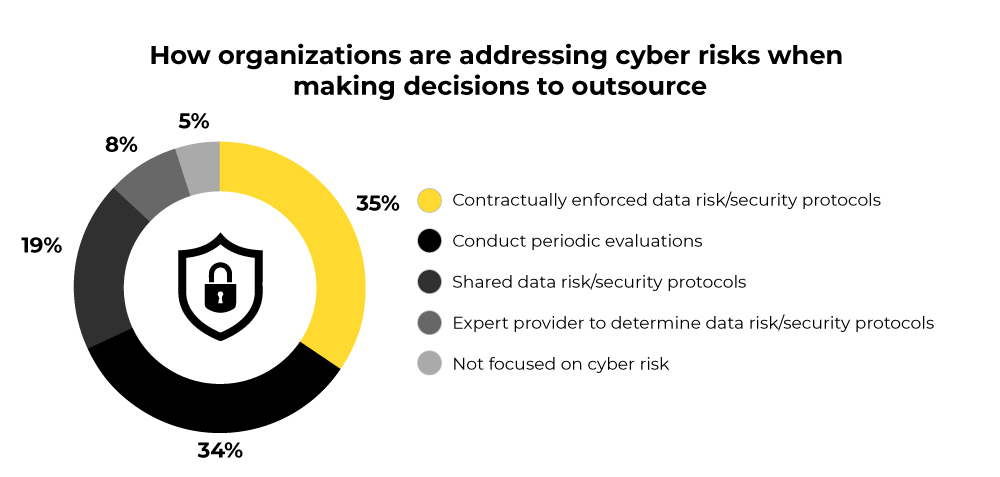Top 3 Outsourcing Business Models for Digital Agencies
- Sara Al-Bakri
- March 11, 2020
- 5 Minute Read

The Deloitte Global Outsourcing Survey 2018 claims that traditional outsourcing has already yielded to disruptive outsourcing. Cloud computing, robotic process automation, and cognitive automation are driving the disruptive IT outsourcing market. An increasing number of companies across industries are adopting different outsourcing business models as a strategy for competitive advantages.
No data is readily available about the total volume of outsourced digital marketing services. However, the global trends in information technology outsourcing (ITO) offer some insights. Digital services outsourcing falls within this larger market.
What’s in this for you?
Well, we begin by providing market facts about the ITO and the risks associated with the various types of outsourcing business models. We’ll also present an overview of different outsourcing business models to outsource digital marketing services, complete with their comparative advantages and disadvantages.
The Global ITO Market
ITO constitutes the largest component of the wider outsourcing market. In 2017, 727 ITO deals were signed globally for the total value of US$ 137.2 billion, according to a KPMG report. Another 220 deals worth US$ 94.2 million combined ITO and BPO (business process outsourcing).
ITO Market: Australia
Australia tops the country ranking in the Asia-Pacific region in terms of the total contract value of ITO deals. It signed 39 ITO deals in 2017, with an additional 3 deals that combined ITO and BPO.
The total value of the ITO deals was US$ 3,562 million, and that of the combined deals was US$ 57 million.
ITO Market: UK
The UK was second in 2017 in terms of total ITO and BPO deals generated, contributing 5.2% to the global value of deals, informs the KPMG report. The country signed 90 ITO deals in 2017 for the total value of US$ 8,359 million.
The country also signed an additional 30 deals that combine BPO and ITO for the total value of US$ 338 million.
ITO Market: USA
The KPMG report informs that the USA generated 84.2% of the ITO-BPO contracts in 2017. The country signed 320 ITO deals that year, the total contract value of which was US$ 102,817. The country also signed 178 ITO-BPO combined deals for the total value of US$ 94,343.
IT talent shortage is the major factor driving the high ITO rate in the USA. The prediction is that US universities will be able to cater to only 30% of the specialist IT jobs that will be available in the country in 2020.
Risks Involved in ITO
Even while the ITO market is growing, it is not free of risks. The following diagram presents the risk perceptions by firms practicing ITO, as captured by the Deloitte report. The diagram also depicts how companies that outsource their digital services are addressing the risks associated with the practice.
It becomes clear from the diagram that data security breach is the highest concern of major firms practicing ITO. While some companies emerge as not yet focused on addressing this risk, most players have adopted different measures to minimize their concern in this area.

The 3 Most Popular IT Outsourcing Business Models
1. Project-Based Outsourcing
The project-based outsourcing model of digital services implies that there is a predetermined goal that the outsourced partner must achieve within a mutually agreed time frame. This model works best when the project requirements are clearly defined and the development time is short.
Advantages:
- This model makes the service provider responsible for the major part of the goals to be achieved.
- This approach is also suitable for smaller companies since no long-term investments are necessary.
Disadvantages:
- The hiring company has little control over the team formation and the management of the entire project.
- Project-based outsourcing business model usually costs higher than other models.
2. Outsourcing to Freelancers
It is possible to use individual freelancers to outsource white label digital marketing services instead of partnering with a company. The decision to hire a company or a freelancer usually depends on the project size. For low-scale projects, hiring freelancers may prove to be more cost-effective.
Advantages:
- Freelancers are less expensive if the project is small, for a limited time, and does not need a wide skills-set.
- It is easier to terminate a freelancing contract than a contract with a company in case the freelancer cannot match up to the needs of the project.
- It is possible to hire different freelancers for several small projects with a short time limit.
- Experienced freelancers with a good project completion record need little time for understanding project needs.
Disadvantages:
- References for freelancers are more difficult to secure than for established companies.
- A freelancer’s goals may not align with the goals of the hiring company.
- If a freelancer asks for a rate revision mid-project, it may cause serious problems for the hiring company.
- A freelancer is the only contact point, which may become a challenge in the case of differing time zones between the hiring company and the freelancer.
- There could be a language barrier problem.
3. Dedicated Team Model
This model means hiring remote service providers who remain dedicated to the provider company but report directly to the hiring company. The remote digital marketing service providers may constitute the full digital marketing team of the hiring company.
Also known as the IT team augmentation model, the remote digital marketing service providers may also work in collaboration with an in-house team of the hiring company. The dedicated team approach works best for long-term needs with changing needs.
Advantages:
- Full control over team members and project management.
- There is scope for changing the project priorities whenever necessary.
- Ensures dedicated service without the need for micromanaging employees.
- A point person is always available for any kind of urgent communication.
Disadvantages:
- The providing company can decide on shifting remote team members without informing the hiring company first. The solution is to make the process the superstar, so that there’s no ‘indispensable superstar’ that everyone has to rely on.
- In the case of any failure, the responsibilities have to be shared by the hiring company and the company providing the digital marketing service.
- Time zone differences and language barriers could be challenging. The solution is to design work shifts such that the client gets 24 x 7 support.
In a Nutshell
Each of the three outsourcing business models is applicable to both onshore and offshore outsourcing. Onshore outsourcing means hiring the services of a white label agency situated in the same country as the hiring company. Offshore outsourcing means hiring a company beyond the national borders of the hiring company.
Increasingly, however, more companies in the global North are moving towards offshore outsourcing business model, for their digital marketing needs. Cost-saving and access to talent are the factors driving this trend. The dedicated team model works best for the medium and long term, because it allows everyone the time and motivation to build robust and quality-focused processes.

Thank you for submitting the details!
We will keep your information safe. Feel free to contact us with any questions at hello@uplers.com
Please check your email for next steps shared by Robert.


















